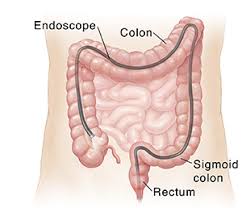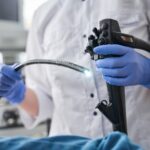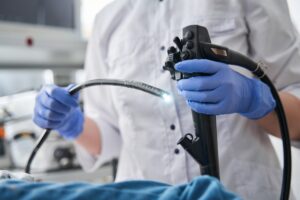
An endoscopy is a procedure done to examine structures inside your body up close. During an endoscopy, a healthcare provider places a long, thin tube (endoscope) inside your body until it reaches the organ or area they need to check. Most endoscopes have a light and special camera at the end. The scope captures images or videos of organs or other body parts. It displays them on a screen your provider sees.
Many endoscopes have special channels inside. Providers can insert operating instruments to remove tissue or perform surgery during an endoscopy.
What are the types of endoscopy?
There are many types of endoscopy procedures. But they all work in the same basic way. A healthcare provider gently inserts a scope into a body opening or small incision. The scope allows them direct access to parts of your body they need to examine or treat.
Key differences include:
- The procedure name. The name usually reflects the organ your provider is checking. For example, a “colonoscopy” is an endoscopy that examines your colon.
- The type of scope. The name usually reflects the organ, too. So the endoscope used for a colonoscopy is called a colonoscope. Endoscopes differ depending on the tasks they help your provider complete. Some are flexible, while others are rigid. Some have channels inside that hold tools that can remove tissue, seal wounds or perform other treatments.
The procedure specifics, including the body parts your provider is examining and where the scope goes in, are different, too.
- Anoscopy: Scope goes through your anus (butthole) to look at your anus and rectum.
- Arthroscopy: Scope goes through an incision above your joint to look for damage or conditions like arthritis.
- Bronchoscopy: Scope goes through your mouth or nostril to look at your trachea (windpipe) and lungs.
- Colonoscopy: Scope goes through your anus to look at your entire large intestine (colon).
- Cystoscopy: Scope goes through your urethra (the tube that allows pee out of your body) to look at it and your bladder.
- Enteroscopy: Scope goes through your mouth (for upper enteroscopy) or your anus (for lower enteroscopy) to look at your small intestine.
- Esophagogastroduodenoscopy (EGD) or upper endoscopy: Scope goes through your mouth to look at your esophagus, stomach and the upper part of your small intestine.
- Hysteroscopy: Scope goes through your vagina to look at your uterus.
- Laparoscopy: Scope goes through an incision in your abdomen to look at your abdominal and reproductive organs.
- Laryngoscopy: Scope goes through your mouth or nostril to look at your voice box (larynx).
- Mediastinoscopy: Scope goes through an incision above your breast bone to look at the area between your lungs that includes your heart, esophagus and windpipe (mediastinum).
- Neuroendoscopy: Scope goes through an incision in your skull to look at your brain.
- Proctoscopy (rigid sigmoidoscopy): Scope goes through your anus to look at your anus and rectum.
- Sigmoidoscopy (flexible sigmoidoscopy): Scope goes through your anus to look at the lower part of your colon (called the sigmoid) and your rectum.
- Thoracoscopy (also called a pleuroscopy): Scope goes through an incision in your chest to look at your lungs and the area around your lungs, including your diaphragm, esophagus and chest walls.
- Ureteroscopy: Scope goes through your urethra to look at the tubes that connect your kidneys to your bladder (ureters).
Advanced endoscopy techniques
Researchers and scientists continually develop new technologies to make endoscopies even less invasive. For example, a capsule endoscopy shows your organs up close without a scope. Instead, you swallow a vitamin-sized capsule with a camera inside. As the capsule travels through your esophagus, stomach and small intestine, it takes pictures that can help diagnose bleeding and tumors in your digestive system.
What does an endoscopy test for?
Healthcare providers use endoscopies to screen for conditions and diagnose diseases. A colonoscopy is probably the most well-known endoscopy used to screen for diseases. It’s used to detect colon cancer. One of the most well-known diagnostic uses of endoscopy is that it allows providers to remove abnormal tissue for lab testing. This is called a biopsy. Biopsies can show if growths are cancerous or noncancerous.
When providers first used endoscopy, they primarily used it to examine organs. Now, they can use endoscopy for many different treatments, such as fixing a bleeding stomach ulcer. In the past, a problem like this could’ve required surgery.
Diseases an endoscopy can detect
An endoscopy can detect diseases that affect your:
- Digestive system, including gastrointestinal diseases, colon polyps and colon cancer.
- Head and neck, including swallowing disorders and laryngitis.
- Joints, including arthritis, tears and dislocations.
- Nervous system, including brain tumors.
- Respiratory system, including lung disease and infections.
- Urinary system, including urinary tract infections (UTIs) and kidney stones.
- Reproductive system, including abnormal uterine bleeding, endometriosis and fertility issues.
Endoscopy treatments
Some endoscopes can be used with instruments that allow providers to:
- Seal wounds.
- Inject medicine.
- Drain fluid.
- Stop internal bleeding.
- Remove damaged tissue or tumors.
- Fix blockages or widen organs that are too narrow.
- Place stents (tiny tubes that open a blocked or damaged organ).
- Perform surgeries.
During a laparoscopy, providers operate on organs through tiny incisions instead of a large opening. This is sometimes called keyhole surgery. It’s much less invasive than traditional surgery. It’s the preferred technique for treating many conditions.
Test Details
How do I prepare for an endoscopy?
You’ll receive instructions based on the type of endoscopy. You may be asked to:
- Complete required pre-tests and procedures. You may need a urine test (urinalysis) to check for a UTI before procedures involving your urinary tract. You may need a pregnancy test before a hysteroscopy.
- Provide a medical history. Alert your healthcare provider of any conditions and medications or supplements you’re taking.
- Fast. You may need to stop eating or drinking for a certain amount of time before your endoscopy. Or, you may need to limit yourself to only certain types of food and drink.
- Cleanse your bowels. You may be asked to complete a bowel prep, which involves flushing the feces (poop) out of your intestines. Colonoscopies, enteroscopies and other procedures involving your lower digestive tract involve bowel prep.
- Stop taking certain medicines. You may need to stop taking blood thinners like warfarin (Coumadin® or Jantoven®) and aspirin. You may need to switch prescription medicines briefly before the procedure. Follow your provider’s guidance.
- Stop smoking. You may need to stop smoking and using tobacco products before your procedure.
- Arrange for someone to drive you home. You won’t be able to drive yourself if you receive sedation or anesthesia for your procedure and go home the same day. Most people need to arrange for a driver.
What should I expect during an endoscopy?
An endoscopy typically takes 30 minutes to two hours, depending on the procedure type. Most people go home on the day of their endoscopy, but some endoscopies require an overnight hospital stay.
Providers use moderate sedation for most endoscopies so that you’re asleep and pain-free during the procedure. General anesthesia (which involves intubation, or placement of a breathing tube) is necessary in a small percentage of cases. Some people may instead get local anesthesia and a sedative. Local anesthesia numbs a particular area instead of putting you to sleep completely. Sedatives help you relax.
Once you’re completely relaxed or asleep, the provider gently inserts the scope until it reaches the area they want to examine. They’ll adjust the scope to display the correct organs or structures on the screen. They’ll note irregular areas and remove tissue or provide treatment if needed.
They’ll close any incisions.
How painful is an endoscopy?
The anesthesia and sedatives prevent you from experiencing pain during the procedure. With some procedures, like a colonoscopy, you may feel pressure when the scope goes in, but the feeling passes quickly.
What should I expect after an endoscopy?
Your care team will monitor your vitals. You’ll likely feel groggy from the anesthesia, but most people go home on the day of their procedure. You may need to take it easy the rest of the day and avoid using any heavy machinery.
Ask your healthcare provider what to expect during recovery, depending on the endoscopy procedure.
What are the side effects of an endoscopy?
Most side effects improve within the first two days. They depend on the type of procedure and where the scope went. For example, you may feel hoarse or have a mild sore throat if the scope was in your throat. You may notice cramps, bloating or nausea if the scope was in your intestines.
Your healthcare provider will recommend ways to manage the discomfort. They’ll prescribe pain medicine as needed.
Results and Follow-Up
When should I know the results of the endoscopy?
Your healthcare provider will let you know when to expect results. They may discuss findings with you the same day, or they may schedule a follow-up appointment to review results with you.
When should I call my healthcare provider?
An endoscopy is a common procedure that’s considered safe. Still, complications, like tears and infections, can happen. Contact your healthcare provider if you notice:
- Signs of an infection, like fever or chills. If you had an incision, look for signs of redness or swelling at the incision site.
- A stool (poop) that looks black and tarry.
- Extreme pain or bleeding at the incision site.
- A cough that won’t go away or coughing up blood.
- Shortness of breath or trouble breathing.
- Chest pain.
Additional Common Questions
Do they put you to sleep for an endoscopy?
It depends. You may be asleep during some endoscopy procedures, including those involving your GI (gastrointestinal) tract. For other types, you may be awake but with medicines that prevent you from feeling any pain.
Your healthcare provider can explain whether you’ll be asleep or awake for your procedure.
A note from Cleveland Clinic
Even with pain meds, having a scope inside your body doesn’t exactly sound pleasant. If it helps, think of the benefits it can provide. Sometimes, it provides visual evidence of conditions that traditional imaging, like an ultrasound, can miss. In this case, an endoscopy can save you a return visit to the provider to take additional views. Certain biopsies can only be done through an endoscopy. For some conditions, endoscopies are the new standard in treatment. They make for faster surgeries with shorter healing times.
Take heart that most endoscopies are only 30 minutes. Chances are, you’ll be in and out the same day, with the peace of mind that you’re valuing your health and taking care of yourself.










